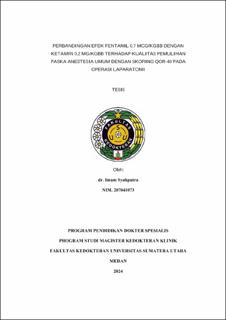Perbandingan Efek Fentanil 0,7 MCG/KGBB dengan Ketamin 0,2 MG/KGBB terhadap Kualitas Pemulihan Paska Anestesia Umum dengan Skoring QoR-40 pada Operasi Laparatomi
Comparison of The Effects of Fentanyl 0.7 MCG/KGBB with Ketamine 0.2 MG/KGBB on The Quality of Recovery Post General Anesthesia with QoR-40 Scoring in Laparatomy Surgery

Date
2024Author
Syahputra, Imam
Advisor(s)
Irina, Rr Sinta
Lubis, Bastian
Metadata
Show full item recordAbstract
Background: Evaluation of post-general anesthesia recovery is crucial in
assessing the final outcome of anesthesia procedures. Quality of Recovery-40
(QoR-40), a questionnaire instrument specifically assesses the quality of postgeneral
anesthesia recovery comprehensively. Researchers are interested in
comparing two types of drugs, namely Fentanyl and ketamine, on the quality of
post-general anesthesia recovery.
Methods: This study is a comparative categorical analytical experimental method
study with a double-blind randomized clinical controlled trial (RCT) design.
Analyzing the comparative effects of fentanyl and ketamine on the quality of postgeneral
anesthesia recovery in laparotomy surgery patients assessed by QoR-40 at
General Hospital Haji Medan. Subject selection technique using consecutive
sampling method where 42 subjects are needed. Bivariate analysis for numeric
variables using the Independent T-test if the data is normally distributed, or the
Mann Whitney U test if the data is not normally distributed. The results of the
analysis are said to be significant if p <0.05, with a confidence level of 95%.
Results: The results of the study showed that the total QoR-40 score for fentanyl
use had an average of 172.4762 + 3.81601, while in the group using ketamine, the
average score was 174.7619 + 3.37498, which had a significant difference
between the fentanyl group and the ketamine group with p <0.05.
Conclusion: Ketamine has better effectiveness than fentanyl in terms of comfort
on the QoR-40 questionnaire, as evidenced by the comfort value for ketamine
being statistically higher than fentanyl.
